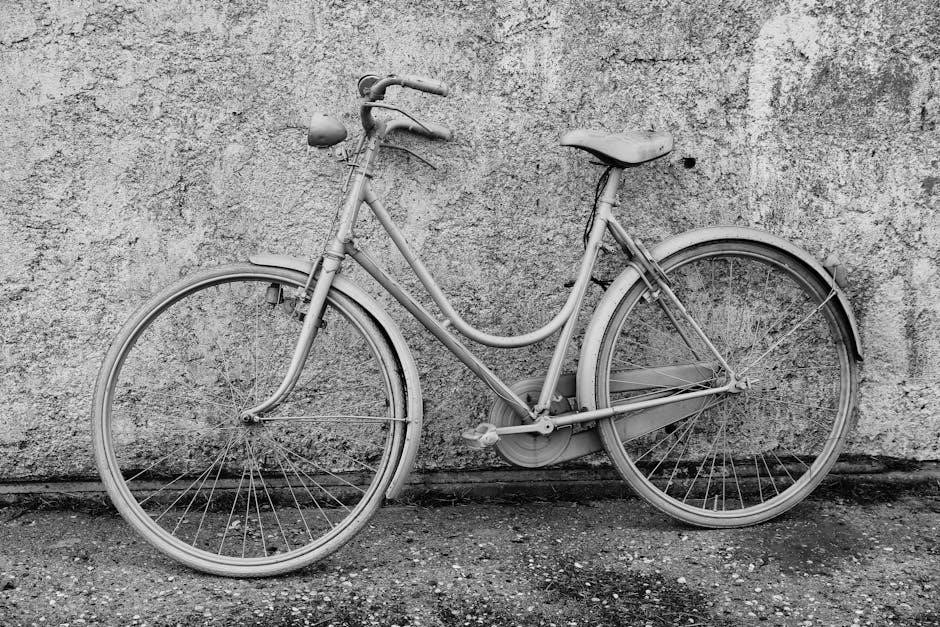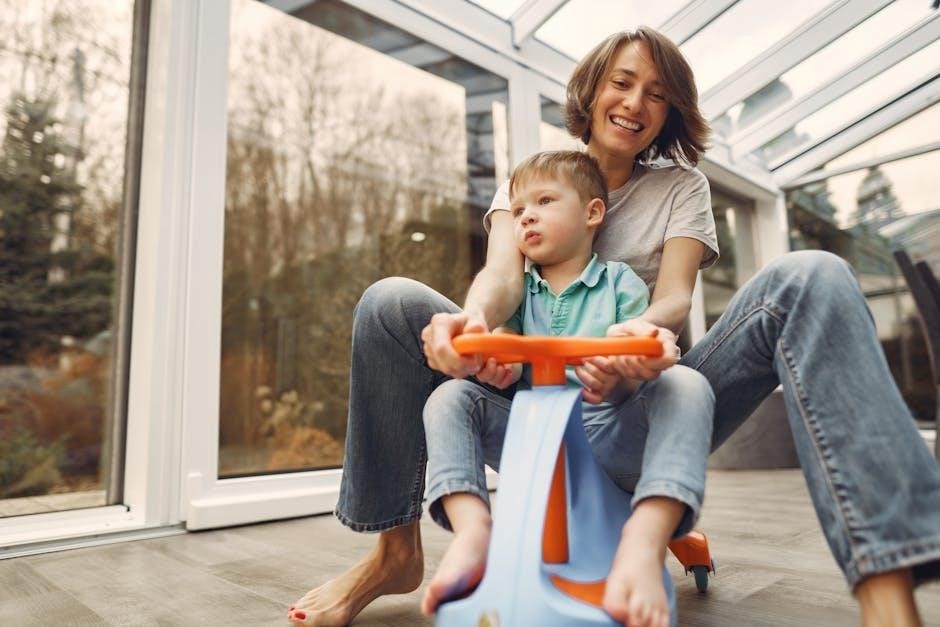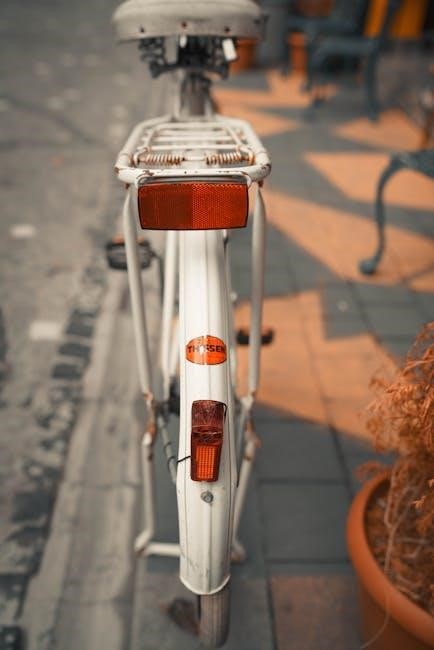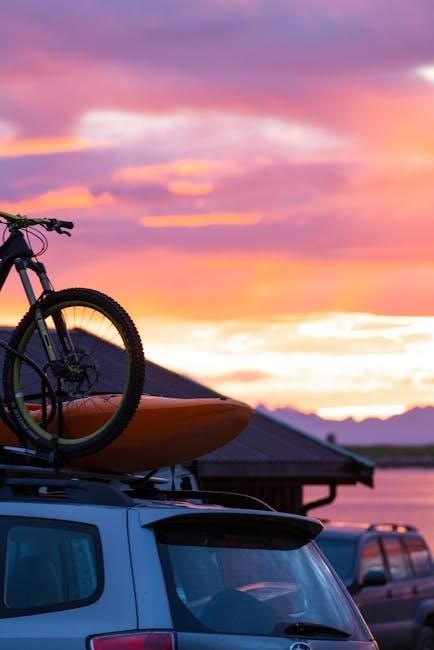Yakima bike carriers are renowned for their durability, versatility, and user-friendly designs, offering a range of models to securely transport bikes of all styles and sizes.
Overview of Yakima Bike Carrier Models
Yakima offers a variety of bike carrier models, including the HoldUp, RidgeBack, KingJoe, and FullBack, each designed for different vehicle types and bike styles. The HoldUp is a tray-style hitch mount, while the RidgeBack features an upright design for easy access. The KingJoe is a trunk-mounted rack, ideal for smaller vehicles, and the FullBack accommodates step-through frames. Each model provides secure, durable transport solutions, ensuring compatibility with diverse bike styles and vehicle setups. Optional locks and accessories enhance security and convenience for users.
Importance of Proper Installation
Proper installation of Yakima bike carriers is critical to ensure safety, prevent damage, and maintain reliability. Incorrect mounting can lead to bike damage, vehicle scratches, or even accidents. Always follow the provided instructions and compatibility guidelines to secure the carrier correctly. Improper attachment may void warranties or compromise the product’s structural integrity. Double-checking all connections and alignments before use is essential for a safe and hassle-free experience. Correct installation ensures your bikes are transported securely, protecting both your vehicle and your gear during transit.

Pre-Installation Checklist
Ensure vehicle compatibility, gather required tools, and review installation manuals. Verify all hardware is included and inspect for damage. Check fitment and safety guidelines before proceeding.
Tools and Hardware Required
To ensure a smooth installation, gather the necessary tools and hardware. Common items include a hex wrench, adjustable wrench, and flathead screwdriver. Hardware like bolts, lock washers, and spacers may be provided or required. Refer to your specific Yakima model’s manual for exact tools needed. Optional accessories, such as lock cores, should be installed according to their instructions. Having all components ready beforehand ensures a hassle-free setup and proper securing of your bike carrier.
Vehicle Compatibility and Fitment
Ensure your Yakima bike carrier is compatible with your vehicle by consulting Yakima’s fit list or Joe Fit Sheet. Compatibility varies by carrier model, such as HoldUp or RidgeBack, and vehicle type. Proper fitment is critical for safety and performance. Avoid using hitch adapters or reducers, as they may compromise stability. Incorrect installation on incompatible vehicles can void warranties or lead to damage. Always verify your vehicle’s specifications and the carrier’s requirements before proceeding with installation.
Safety Precautions and Warnings

Always follow Yakima’s instructions and guidelines to ensure safe installation and use. Never exceed the carrier’s weight capacity or vehicle’s towing limits. Avoid using hitch adapters, extenders, or reducers, as they may compromise stability. Ensure all components are securely tightened and properly aligned. Do not modify the carrier or use it for purposes other than its intended design. Improper installation can result in damage, injury, or accident. Regularly inspect the carrier and bikes for securement before driving. Adhere to local regulations for bike transportation.

Step-by-Step Installation Guide
Attach the carrier to the hitch or roof using the provided hardware. Insert the bolt and lock-washer, aligning holes properly. Tighten securely with an adjustable wrench. Ensure the carrier is level and firmly attached to prevent movement. Avoid using hitch adapters or extenders. Double-check all connections for stability and safety before loading bikes. Proper alignment and securement are critical to prevent damage or injury during transport. Always follow Yakima’s specific instructions for your model.
Mounting the Carrier to the Vehicle
Begin by removing the end cap from the carrier using a flathead screwdriver. Insert the bolt and lock-washer through the vehicle’s hitch or roof mounting points, ensuring proper alignment of holes. Tighten the bolt securely with an adjustable wrench until the carrier feels stable. Check that the carrier is level and evenly positioned on the vehicle. Refer to Yakima’s Fit List to confirm compatibility with your vehicle. Avoid using hitch adapters or extenders, as they may compromise stability. Ensure all connections are snug and the carrier is firmly attached before proceeding. Proper mounting is essential for safe and secure transport.
Securing the Carrier to the Hitch or Roof
Use the provided hex wrench to tighten the SpeedKnob or bolt securely into the hitch or roof mounting points. Ensure the carrier is snug and even, avoiding any wobble. For hitch-mounted carriers, tighten to the recommended torque specification (typically 17 ft-lbs) to prevent loosening during travel. For roof-mounted systems, follow the manufacturer’s clamp-tightening sequence. Double-check the carrier’s stability by gently rocking it. If using locks, install the lock cores as per the instructions and secure the bikes to the carrier. Always verify the carrier’s position and security before driving. Properly securing the carrier is crucial for safe bike transport.
Adjusting and Tightening the Carrier
After mounting, adjust the carrier to ensure proper alignment with your vehicle. Use the provided hex wrench to tighten the SpeedKnob or bolts securely, following the specified torque (typically 17 ft-lbs). For roof-mounted systems, tighten clamps in the recommended sequence to avoid damage. Test stability by gently rocking the carrier; ensure no wobble. If using locks, install lock cores as instructed. Double-check all straps and clamps for tightness. A final inspection ensures everything is secure and properly aligned for safe transport.

Loading and Securing Bikes
Place bikes on the carrier, ensuring proper alignment and spacing. Secure frames and wheels using straps or clamps. Tighten all fasteners and test stability before travel.
Proper Bike Placement on the Carrier
Place bikes on the carrier with proper alignment, ensuring the bike’s frame or wheels are securely fastened. For most bikes, attach the frame or top tube to the carrier. Center the bike on the rack to maintain balance and avoid interference with other bikes or vehicle components. Ensure wheels are properly seated in trays or straps. For step-through or ladies’ frames, use a TubeTop adapter for safe transport. Always double-check that bikes are centered and evenly spaced to maximize stability and prevent damage during transit.
Using Straps and Locks for Securement
Secure bikes using the provided straps, ensuring they are snug and evenly tightened around the frame or wheels. For added safety, use Yakima’s optional locking systems, such as the HandCuff locking cable, to deter theft. Install lock cores according to the manufacturer’s instructions, typically by removing the lock plug and inserting the core. Always double-check that straps and locks are properly engaged before driving. This ensures your bikes remain stable and secure during transit, protecting both your vehicle and your bikes from damage or theft.
Maximizing Carrier Capacity
To maximize your Yakima bike carrier’s capacity, ensure bikes are loaded evenly and securely. Alternate bike directions to optimize space and minimize interference. Use the provided cradles or stabilizers to hold bikes firmly in place, preventing movement during transit. For carriers with higher capacities (like 2 or 3 bikes), position heavier bikes near the vehicle for better balance. Always check the weight and bike limits specified in your model’s instructions. Consider optional accessories, such as the TubeTop, for bikes with unique frames to ensure proper fit and safety.
Post-Installation Checks
Ensure your Yakima carrier is stable, properly aligned, and all components are securely tightened. This final check ensures safe transport and prevents potential damage during travel.
Testing the Carrier’s Stability
To ensure your Yakima bike carrier is securely installed, gently shake the carrier to check for any movement. Verify that all bolts and straps are tightened properly and that the carrier remains stable under light force. Perform a test drive at a moderate speed to confirm the carrier’s stability and alignment. If any wobbling or shifting occurs, recheck the installation and tighten any loose components. This step is crucial for safe transportation and preventing potential damage to your bike or vehicle.
Ensuring Proper Alignment
Proper alignment is critical for safe and secure bike transportation. Ensure the carrier is centered on your vehicle and aligned with the frame or hitch. Refer to Yakima’s fit sheet for specific guidance. Visually inspect the carrier to confirm it is straight and evenly seated. Misalignment can lead to instability during transit. Double-check all connections and adjustments to maintain proper alignment, ensuring your bikes are transported safely and securely. This step prevents potential damage to both the carrier and your vehicle.
Final Tightening of All Components
After completing the installation, perform a final tightening of all components to ensure stability and safety. Use a torque wrench to tighten bolts to the manufacturer’s specified torque ratings, as outlined in the Yakima instructions. Double-check all fasteners, straps, and locks to confirm they are securely in place. Properly tightened components prevent rattling and ensure your bikes remain stable during transit. Always refer to your specific Yakima model’s manual for precise torque specifications and guidelines for final adjustments.
Maintenance and Troubleshooting
Regular maintenance ensures longevity and safety. Clean moving parts, lubricate hinges, and inspect for wear. Address issues promptly to prevent damage. Refer to the manual for troubleshooting.
Cleaning and Lubricating Moving Parts
Regularly clean Yakima bike carriers with a soft cloth and mild detergent to remove dirt and grime. Avoid harsh chemicals or abrasive materials that could damage finishes. Lubricate all moving parts, such as hinges and bolts, with a silicone-based spray to ensure smooth operation. Inspect components for wear and tear, replacing any damaged or corroded parts. Proper maintenance extends the lifespan of your carrier and ensures safe, reliable performance during trips.
Identifying and Resolving Common Issues
Common issues with Yakima bike carriers include loose bolts, rust, or misalignment. Inspect the carrier regularly for wear and tear. Tighten any loose hardware and apply lubricant to moving parts. For rust, clean and treat affected areas with a rust-inhibiting spray. If parts are misaligned, adjust according to the installation manual. For persistent problems, consult Yakima’s troubleshooting guide or contact customer support. Proper care ensures your carrier functions optimally and safely transports your bikes.
Updating or Replacing Worn-Out Parts
Regularly inspect your Yakima bike carrier for worn-out parts, such as straps, bolts, or locks. Replace any damaged components to ensure safe and secure bike transport. Order replacement parts directly from Yakima or authorized dealers to maintain compatibility and quality. Follow the instructions provided with the new parts for proper installation. Updating your carrier ensures optimal performance, prevents further damage, and extends its lifespan. Always prioritize replacing worn parts to guarantee your bike carrier functions safely and efficiently on every trip.
Yakima bike carriers offer a reliable and efficient way to transport bikes, ensuring safety and convenience for outdoor enthusiasts. Follow instructions carefully to enjoy the adventure.
Key Takeaways for Successful Use
Proper installation and alignment are crucial for safe and secure bike transport. Always follow Yakima’s fit list and instructions to ensure compatibility with your vehicle. Regular maintenance, such as cleaning and lubricating moving parts, prolongs the carrier’s lifespan. Use straps and locks to secure bikes firmly, and maximize capacity by evenly distributing bike weight. Familiarize yourself with features like tilt mechanisms and lock cores for added convenience and security. Double-check all connections before driving to ensure a trouble-free experience.
Encouragement for Further Exploration
Exploring Yakima’s diverse range of bike carriers can enhance your cycling adventures. From models like the HoldUp to the RidgeBack, each offers unique features tailored to different bike types and vehicle setups. Dive into instructional videos and guides to master installation and maintenance. Whether you’re a casual rider or an enthusiast, Yakima’s innovative designs ensure durability and ease of use. Visit their website or local dealers to discover more about their products and accessories, ensuring your next adventure is seamless and enjoyable for years to come.

Leave a Reply